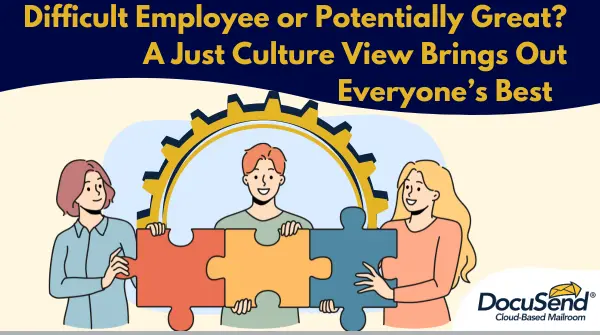Difficult Employee or Potentially Great? A Just Culture View Brings Out Everyone’s Best

In the business world, being adept at shaping a highly motivated team is arguably the most valuable skill an owner or manager can have. Some of you may be familiar with the advice to warn the idle, encourage the fainthearted, help the weak, and be patient with them all. But the difficulty is in knowing the difference so you can treat each person accordingly.
The key just may be found in seeing them through the lens of the just culture model.
What Defines a Just Culture?
One of the ways to understand just culture is to look at what it’s not. Often businesses take a no harm, no foul attitude: A person who could have prevented a problem gets off easy as long as no real damage ensued. Instead, under the just culture model, risky behaviors are addressed even if no damage was done, and disciplinary actions are proportional. The assessment of the situation starts off by determining whether the action was intentional.
When applied consistently, the principles of the just culture model create in employees an ethic of answerability yet one of trust where they feel that it’s safe to report mistakes. The focus is on learning from incidents rather than on blame; taking away the fear of repercussions makes a transparent and equitable work environment.
The just culture model categorizes incidents as human error, at-risk behavior, and reckless misconduct.
- Human error: In a just culture, human errors are expected and considered a natural outcome of trying to get things done. Instead of a knee-jerk reaction of looking for where to place blame for something that was an honest mistake, the first response to an issue should be to step back and seek a clear understanding of why it happened in the first place, with a view to building safeguards against it. For example, if a sales rep accidentally enters an incorrect price for a product or service, identify how it could have happened. Perhaps there were hazy pricing guidelines, or maybe a lack of training was the cause. The goal is not only to address the immediate problem, but also to minimize repeat mistakes.
- At-risk behavior: These are behaviors that bypass protocols for safety or correct process. The just culture model is intended to deal with such circumstances by fostering open communication. The solution is often training or guidance. For instance, if someone on the factory floor skips a safety inspection to meet a delivery deadline, the just culture approach will entail discussing the reasons for it with the employee and working together toward a solution that prioritizes safety as well as efficiency.
- Reckless misconduct: Actions done deliberately while recklessly disregarding known regulations or procedures are disciplined within a just culture. Behaviors like this are considered extremely serious, without regard to their outcome. If, for example, a person obtains unauthorized access to confidential information, the company will need to act on it even if the information was not shared. A thorough investigation may be launched and appropriate disciplinary measures taken.
How does this fit with knowing who needs a warning, some encouragement, or a little help?
Who Needs What?
First, in a just culture, the only ones who get warned or sanctioned are those who feel entitled, whose performance shows that they are not putting in an effort, or they demonstrate by their actions that they simply don’t care about their work, their coworkers, or the company. And yes, they need this. It does no one any favors to let their character devolve—because none of us is ever standing still; we’re either getting better or going downhill. Receiving appropriately firm correction is a kindness that many people have expressed thanks for later on.
Second, if someone doubts their true value to the organization or lacks the confidence to step out and make suggestions, encouraging them in the best way possible starts with putting yourself in their place. Remember how it felt when you were just starting out in a new area, whether on the job or in any other aspect of your life. (How about as a new parent?) Express genuine appreciation for what they do, and continually remind them they are an integral part of the team. And never pass up the chance to pass along a compliment: “The client whose issue you resolved yesterday said you were extremely helpful/professional/personable.” “Your team member said she couldn’t have accomplished the project nearly as fast without you.”
Third, the members who are perceived as weak in your organization can blossom into your most valuable employees with the right support. Help those who are new at the game by providing mentoring. Provide those from a different language background with good translation tools and make a native speaker available to them to answer communication and cultural questions. Ask those who are physically challenged what the obstacles are in the workplace and invest in ways to accommodate them. For workers with mental challenges, providing not only employee mental health services, but also flexibility is key. If you give them the time and space they need on their bad days, they can be some of your most loyal, dedicated, and supportive team members.
Empathy, not enabling, is what is needed in the second and third cases. Enabling people to stay timid or weak would be to jump in and do their job or be hasty to assign it to someone else. Even if it’s critical path, you can keep them in as to assist or at least observe, depending on the nature of the task. Empathy can empower; enabling always weakens further.
In all three aspects, warning the idle, encouraging the fainthearted, and helping the weak, the overriding principle of a just culture is patience. First, it takes time to develop an atmosphere where everyone is willing to report errors, eager to learn from mistakes, and finds fulfillment in working collaboratively to improve company procedures. Then, when an incident occurs, remember that assigning blame is a shortcut; it won’t keep it from happening next time. To do that requires patiently working back through events until you find the root of the problem.
Here at DocuSend, we are proud to have built our online print-to-mail services in a culture of continuous personal and professional growth with accountability and fairness for all, which has led to more resiliency and success for us and a great track record for client satisfaction. Join us in propagating this business culture by sharing in the comments section the ways you have followed just practices in your organization.

